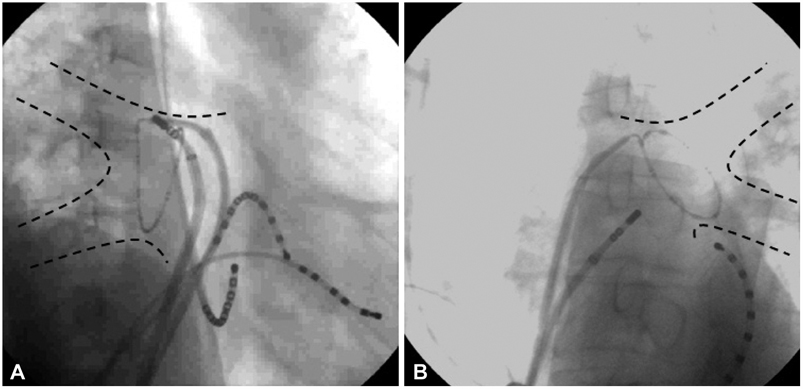Korean Circ J.
2011 Aug;41(8):447-452. 10.4070/kcj.2011.41.8.447.
The Feasibility and Efficacy of a Large-Sized Lasso Catheter Combined With 3 Dimensional Mapping System for Catheter Ablation of Atrial Fibrillation
- Affiliations
-
- 1Division of Cardiology, Department of Internal Medicine, The Catholic University of Korea College of Medicine, Seoul, Korea. oys@catholic.ac.kr
- KMID: 1826351
- DOI: http://doi.org/10.4070/kcj.2011.41.8.447
Abstract
- BACKGROUND AND OBJECTIVES
We aimed to investigate whether a large-sized Lasso catheter could increase the success rate of immediate complete pulmonary vein (PV) antral isolation and improve the outcome of catheter ablation in atrial fibrillation (AF) patients.
SUBJECTS AND METHODS
This study included 107 consecutive patients (67 males, mean age: 57.8+/-9.7 years) who underwent PV mapping and ablation due to symptomatic drug-refractory AF. The first 43 patients underwent isolation of both ipsilateral PVs using the Carto-Merge 3 dimensional mapping system (group 1). The other 64 patients underwent isolation of both ipsilateral PVs using the same technique with a large-sized (a diameter of 30 to 35 mm) Lasso cathe-ter (group 2). When ipsilateral PVs did not show any potential after the initial circumferential ablation, we defined this as 'immediate complete antral isolation (ICAI)'. We compared the AF recurrence rate of both groups.
RESULTS
There was no significant difference of the clinical characteristics between group 1 and group 2. All the patients were followed-up for 1 year. The ICAI rate of group 1 and group 2 was significantly different (21% vs. 78%, p<0.001), and the AF recurrence rates of group 1 and group 2 were also different (34.9% vs. 18.8%, p=0.042). Using multiple logistic regression analysis, the use of a large-sized Lasso catheter was a significant predictive factor for preventing recurrence (odds ratio: 0.489, 95% confidence interval: 0.136-0.927).
CONCLUSION
It is likely that a large-sized Lasso catheter plays an important role in achieving ICAI and in lowering the rate of AF recurrence.
MeSH Terms
Figure
Reference
-
1. Haissaguerre M, Jais P, Shah DC, et al. Spontaneous initiation of atrial fibrillation by ectopic beats originating in the pulmonary veins. N Engl J Med. 1998. 339:659–666.2. Nam KB, Choi KJ, Park DW, Kim J, Rhee KS, Kim YH. Electrophysiological characteristics of arterially-perfused canine pulmonary veins: role of the delayed afterdepolarization-induced triggered activity. Korean Circ J. 2005. 35:643–648.3. Jais P, Haissaguerre M, Shah DC, et al. A focal source of atrial fibrillation treated by discrete radiofrequency ablation. Circulation. 1997. 95:572–576.4. Haissaguerre M, Jais P, Shah DC, et al. Electrophysiological end point for catheter ablation of atrial fibrillation initiated from multiple pulmonary venous foci. Circulation. 2000. 101:1409–1417.5. Chen SA, Tai CT, Tsai CF, Hsieh MH, Ding YA, Chang MS. Radiofrequency catheter ablation of atrial fibrillation initiated by pulmonary vein ectopic beats. J Cardiovasc Electrophysiol. 2000. 11:218–227.6. Oral H, Knight BP, Ozaydin M, et al. Segmental ostial ablation to isolate the pulmonary veins during atrial fibrillation: feasibility and mechanistic insights. Circulation. 2002. 106:1256–1262.7. Ouyang F, Bansch D, Ernst S, et al. Complete isolation of left atrium surrounding the pulmonary veins: new insights from the double-Lasso technique in paroxysmal atrial fibrillation. Circulation. 2004. 110:2090–2096.8. Ouyang F, Ernst S, Chun J, et al. Electrophysiological findings during ablation of persistent atrial fibrillation with electroanatomic mapping and double Lasso catheter technique. Circulation. 2005. 112:3038–3048.9. Dong J, Dickfeld T, Dalal D, et al. Initial experience in the use of integrated electroanatomic mapping with three-dimensional MR/CT images to guide catheter ablation of atrial fibrillation. J Cardiovasc Electrophysiol. 2006. 17:459–466.10. Hocini M, Jais P, Sanders P, et al. Techniques, evaluation, and consequences of linear block at the left atrial roof in paroxysmal atrial fibrillation: a prospective randomized study. Circulation. 2005. 112:3688–3696.11. Jais P, Hocini M, Hsu LF, et al. Technique and results of linear ablation at the mitral isthmus. Circulation. 2004. 110:2996–3002.12. Yamane T, Date T, Kanzaki Y, et al. Segmental pulmonary vein antrum isolation using the "large-size" lasso catheter in patients with atrial fibrillation. Circ J. 2007. 71:753–760.13. Oral H, Scharf C, Chugh A, et al. Catheter ablation for paroxysmal atrial fibrillation: segmental pulmonary vein ostial ablation versus left atrial ablation. Circulation. 2003. 108:2355–2360.14. Arentz T, Weber R, Burkle G, et al. Small or large isolation areas around the pulmonary veins for the treatment of atrial fibrillation? Results from a prospective randomized study. Circulation. 2007. 115:3057–3063.15. Cheema A, Dong J, Dalal D, et al. Long-term safety and efficacy of circumferential ablation with pulmonary vein isolation. J Cardiovasc Electrophysiol. 2006. 17:1080–1085.16. Ouyang F, Antz M, Ernst S, et al. Recovered pulmonary vein conduction as a dominant factor for recurrent atrial tachyarrhythmias after complete circular isolation of the pulmonary veins: lessons from double Lasso technique. Circulation. 2005. 111:127–135.
- Full Text Links
- Actions
-
Cited
- CITED
-
- Close
- Share
- Similar articles
-
- Large Circular Ring Catheter Ablation Versus Anatomically Guided Ablation of Atrial Fibrillation: Back to the Future for Successful Catheter Ablation of Atrial Fibrillation?
- A Case of Successful Ablation of Right-Sided Accessory Pathway during Atrial Fibrillation
- Catheter Ablation of Atrial Fibrillation
- Drug Therapy and Catheter Ablation for Atrial Fibrillation
- A Case of Chronic Radiodermatitis following Radiofrequency Catheter Ablation for Atrial Fibrillation




